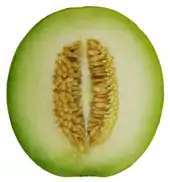Watermelon
Watermelon (Citrullus lanatus) is a flowering plant species of the Cucurbitaceae family . A scrambling and trailing vine-like plant, it was originally domesticated in Africa. It is a highly cultivated fruit worldwide, with more than 1,000 varieties.
| Watermelon | |
|---|---|
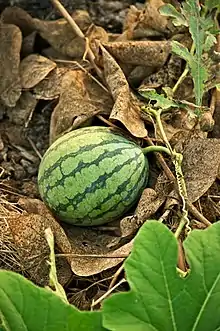 | |
| Watermelon | |
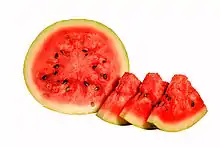 | |
| Watermelon cross section | |
| Scientific classification | |
| Kingdom: | Plantae |
| Clade: | Tracheophytes |
| Clade: | Angiosperms |
| Clade: | Eudicots |
| Clade: | Rosids |
| Order: | Cucurbitales |
| Family: | Cucurbitaceae |
| Genus: | Citrullus |
| Species: | C. lanatus |
| Binomial name | |
| Citrullus lanatus | |
| Synonyms[1] | |
|
List
| |

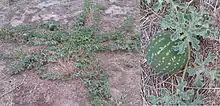
Wild watermelon seeds have been found in the prehistoric Libyan site of Uan Muhuggiag.[2] There is also evidence from seeds in Pharaoh tombs of watermelon cultivation in Ancient Egypt.
Watermelon is grown in favorable climates from tropical to temperate regions worldwide for its large edible fruit, which is a berry with a hard rind and no internal divisions, and is botanically called a pepo. The sweet, juicy flesh is usually deep red to pink, with many black seeds, although seedless varieties exist. The fruit can be eaten raw or pickled, and the rind is edible after cooking. It may also be consumed as a juice or as an ingredient in mixed beverages.
Considerable breeding effort has developed disease-resistant varieties. Many cultivars are available that produce mature fruit within 100 days of planting. In 2017, China produced about two-thirds of the world total of watermelons.
Description
The watermelon is an annual that has a prostrate or climbing habit. Stems are up to 3 metres (10 feet) long and new growth has yellow or brown hairs. Leaves are 60 to 200 millimetres (2 1⁄4 to 7 3⁄4 inches) long and 40 to 150 mm (1 1⁄2 to 6 in) wide. These usually have three lobes which are themselves lobed or doubly lobed. Plants have both male and female flowers on 40-millimetre-long (1 1⁄2 in) hairy stalks. These are yellow, and greenish on the back.[3]
The watermelon is a large annual plant with long, weak, trailing or climbing stems which are five-angled (five-sided) and up to 3 m (10 ft) long. Young growth is densely woolly with yellowish-brown hairs which disappear as the plant ages. The leaves are large, coarse, hairy pinnately-lobed and alternate; they get stiff and rough when old. The plant has branching tendrils. The white to yellow flowers grow singly in the leaf axils and the corolla is white or yellow inside and greenish-yellow on the outside. The flowers are unisexual, with male and female flowers occurring on the same plant (monoecious). The male flowers predominate at the beginning of the season; the female flowers, which develop later, have inferior ovaries. The styles are united into a single column.
The large fruit is a kind of modified berry called a pepo with a thick rind (exocarp) and fleshy center (mesocarp and endocarp).[4] Wild plants have fruits up to 20 cm (8 in) in diameter, while cultivated varieties may exceed 60 cm (24 in). The rind of the fruit is mid- to dark green and usually mottled or striped, and the flesh, containing numerous pips spread throughout the inside, can be red or pink (most commonly), orange, yellow, green or white.[5][6]
A bitter watermelon has become naturalized in semiarid regions of several continents, and is designated as a "pest plant" in parts of Western Australia where they are called "pig melon".[7]
The species has two varieties, watermelons (Citrullus lanatus (Thunb.) var. lanatus) and citron melons (Citrullus lanatus var. citroides (L. H. Bailey) Mansf.), originated with the erroneous synonymization of Citrullus lanatus (Thunb.) Matsum. & Nakai and Citrullus vulgaris Schrad. by L.H. Bailey in 1930.[8] Molecular data including sequences from the original collection of Thunberg and other relevant type material, show that the sweet watermelon (Citrullus vulgaris Schrad.) and the bitter wooly melon Citrullus lanatus (Thunb.) Matsum. & Nakai are not closely related to each other.[9] A proposal to conserve the name, Citrullus lanatus (Thunb.) Matsum. & Nakai, was accepted by the nomenclature committee and confirmed at the International Botanical Congress in 2017.[10]
Taxonomy
The sweet watermelon was formally described by Carl Linnaeus in 1753 and given the name Cucurbita citrullus. It was reassigned to the genus Citrullus in 1836, under the replacement name Citrullus vulgaris, by the German botanist Heinrich Adolf Schrader.[11] (The International Code of Nomenclature for algae, fungi, and plants does not allow names like "Citrullus citrullus".)
The bitter wooly melon is the sister species of Citrullus ecirrhosus Cogn. from South African arid regions, while the sweet watermelon is closer to Citrullus mucosospermus (Fursa) Fursa from West Africa and populations from Sudan.[12] The bitter wooly melon was formally described by Carl Peter Thunberg in 1794 and given the name Momordica lanata.[13] It was reassigned to the genus Citrullus in 1916 by Japanese botanists Jinzō Matsumura and Takenoshin Nakai.[14]
History
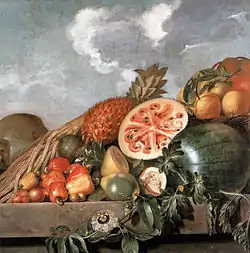
_Matsum._%2526_Nakai_-_Cucurbita_maxima_Duchesne%252C_1804.jpg.webp)
The watermelon is a flowering plant that originated in Africa, though there is conflicting research about whether its source is West Africa[15] or Northeast Africa.[16]
Evidence of the cultivation of both C. lanatus and C. colocynthis in the Nile Valley has been found from the second millennium BC onward, and seeds of both species have been found at Twelfth Dynasty sites and in the tomb of Pharaoh Tutankhamun.[17] Watermelons were cultivated for their high water content and were stored to be eaten during dry seasons, not only as a food source, but as a method of storing water.[16] Watermelon seeds were also found in the Dead Sea region at the ancient settlements of Bab edh-Dhra and Tel Arad.[18]
A number of 5000-year old wild watermelon seeds (C. lanatus) were discovered at Uan Muhuggiag, a prehistoric archaeological site located in southwestern Libya. This archaeobotanical discovery may support the possibility that the plant was more widely distributed in the past.[2][16]
In the 7th century, watermelons were being cultivated in India, and by the 10th century had reached China, which is today the world's single largest watermelon producer. The Moors introduced the fruit into the Iberian Peninsula and there is evidence of it being cultivated in Córdoba in 961 and also in Seville in 1158. It spread northwards through southern Europe, perhaps limited in its advance by summer temperatures being insufficient for good yields. The fruit had begun appearing in European herbals by 1600, and was widely planted in Europe in the 17th century as a minor garden crop.[5]
European colonists and slaves from Africa introduced the watermelon to the New World. Spanish settlers were growing it in Florida in 1576, and it was being grown in Massachusetts by 1629, and by 1650 was being cultivated in Peru, Brazil and Panama. Around the same time, Native Americans were cultivating the crop in the Mississippi valley and Florida. Watermelons were rapidly accepted in Hawaii and other Pacific islands when they were introduced there by explorers such as Captain James Cook.[5] In the Civil War era United States, watermelons were commonly grown by free black people and became one symbol for the abolition of slavery.[19] After the Civil War, black people were maligned for their association with watermelon. The sentiment evolved into a racist stereotype where black people shared a supposed voracious appetite for watermelon, a fruit long correlated with laziness and uncleanliness.[20]
Seedless watermelons were initially developed in 1939 by Japanese scientists who were able to create seedless triploid hybrids which remained rare initially because they did not have sufficient disease resistance.[21] Seedless watermelons became more popular in the 21st century, rising to nearly 85% of total watermelon sales in the United States in 2014.[22]
Cultivation
Watermelons are plants grown in climates from tropical to temperate, needing temperatures higher than about 25 °C (77 °F) to thrive. On a garden scale, seeds are usually sown in pots under cover and transplanted into well-drained sandy loam with a pH between 5.5 and 7, and medium levels of nitrogen.
Major pests of the watermelon include aphids, fruit flies, and root-knot nematodes. In conditions of high humidity, the plants are prone to plant diseases such as powdery mildew and mosaic virus.[23] Some varieties often grown in Japan and other parts of the Far East are susceptible to fusarium wilt. Grafting such varieties onto disease-resistant rootstocks offers protection.[5]
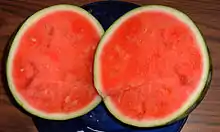
The US Department of Agriculture recommends using at least one beehive per acre (4,000 m2 per hive) for pollination of conventional, seeded varieties for commercial plantings. Seedless hybrids have sterile pollen. This requires planting pollinizer rows of varieties with viable pollen. Since the supply of viable pollen is reduced and pollination is much more critical in producing the seedless variety, the recommended number of hives per acre (pollinator density) increases to three hives per acre (1,300 m2 per hive). Watermelons have a longer growing period than other melons, and can often take 85 days or more from the time of transplanting for the fruit to mature.[24] Lack of pollen is thought to contribute to "hollow heart" which causes the flesh of the watermelon to develop a large hole, sometimes in an intricate, symmetric shape. Watermelons suffering from hollow heart are safe to consume.[25][26]
Farmers of the Zentsuji region of Japan found a way to grow cubic watermelons by growing the fruits in metal and glass boxes and making them assume the shape of the receptacle.[27] The cubic shape was originally designed to make the melons easier to stack and store, but these "square watermelons" may be triple the price of normal ones, so appeal mainly to wealthy urban consumers.[27] Pyramid-shaped watermelons have also been developed and any polyhedral shape may potentially be used.[28]
Cultivar groups
A number of cultivar groups have been identified:[29]
Citroides group
(syn. C. lanatus subsp. lanatus var. citroides; C. lanatus var. citroides; C. vulgaris var. citroides)[29]
DNA data reveal that C. lanatus var. citroides Bailey is the same as Thunberg's bitter wooly melon, C. lanatus and also the same as C. amarus Schrad. It is not a form of the sweet watermelon C. vulgaris and not closely related to that species.
The citron melon or makataan – a variety with sweet yellow flesh that is cultivated around the world for fodder, and the production of citron peel and pectin.[3]
Lanatus group
(syn. C. lanatus var. caffer)[29]
C. caffer Schrad. is a synonym of C. amarus Schrad.
The variety known as tsamma is grown for its juicy white flesh. The variety was an important food source for travellers in the Kalahari Desert.[3]
Another variety known as karkoer or bitterboela is unpalatable to humans, but the seeds may be eaten.[3]
A small-fruited form with a bumpy skin has caused poisoning in sheep.[3]
Vulgaris group
This is Linnaeus's sweet watermelon; it has been grown for human consumption for thousands of years.[3]
- C. lanatus mucosospermus (Fursa) Fursa
This West African species is the closest wild relative of the watermelon. It is cultivated for cattle feed.[3]
Additionally, other wild species have bitter fruit containing cucurbitacin.[30] C. colocynthis (L.) Schrad. ex Eckl. & Zeyh., C. rehmii De Winter, and C. naudinianus (Sond.) Hook.f.
Varieties
The more than 1,200[31] cultivars of watermelon range in weight from less than 1 kilogram (2 1⁄4 pounds) to more than 90 kg (200 lb); the flesh can be red, pink, orange, yellow or white.[24]
- The 'Carolina Cross' produced the current world record for heaviest watermelon, weighing 159 kg (351 lb).[32] It has green skin, red flesh and commonly produces fruit between 29 and 68 kg (65 and 150 lb). It takes about 90 days from planting to harvest.[33]
- The 'Golden Midget' has a golden rind and pink flesh when ripe, and takes 70 days from planting to harvest.[34]
- The 'Orangeglo' has a very sweet orange flesh, and is a large, oblong fruit weighing 9–14 kg (20–31 lb). It has a light green rind with jagged dark green stripes. It takes about 90–100 days from planting to harvest.[35]
- The 'Moon and Stars' variety was created in 1926.[36] The rind is purple/black and has many small yellow circles (stars) and one or two large yellow circles (moon). The melon weighs 9–23 kg (20–51 lb).[37] The flesh is pink or red and has brown seeds. The foliage is also spotted. The time from planting to harvest is about 90 days.[38]
- The 'Cream of Saskatchewan' has small, round fruits about 25 cm (10 in) in diameter. It has a thin, light and dark green striped rind, and sweet white flesh with black seeds. It can grow well in cool climates. It was originally brought to Saskatchewan, Canada, by Russian immigrants. The melon takes 80–85 days from planting to harvest.[39]
- The 'Melitopolski' has small, round fruits roughly 28–30 cm (11–12 in) in diameter. It is an early ripening variety that originated from the Astrakhan region of Russia, an area known for cultivation of watermelons. The Melitopolski watermelons are seen piled high by vendors in Moscow in the summer. This variety takes around 95 days from planting to harvest.[40]
- The 'Densuke' watermelon has round fruit up to 11 kg (24 lb). The rind is black with no stripes or spots. It is grown only on the island of Hokkaido, Japan, where up to 10,000 watermelons are produced every year. In June 2008, one of the first harvested watermelons was sold at an auction for 650,000 yen (US$6,300), making it the most expensive watermelon ever sold. The average selling price is generally around 25,000 yen ($250).[41]
- Many cultivars are no longer grown commercially because of their thick rind, but seeds may be available among home gardeners and specialty seed companies. This thick rind is desirable for making watermelon pickles, and some old cultivars favoured for this purpose include 'Tom Watson', 'Georgia Rattlesnake', and 'Black Diamond'.[42]
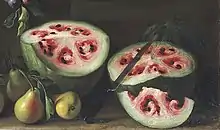
Variety improvement
Charles Fredrick Andrus, a horticulturist at the USDA Vegetable Breeding Laboratory in Charleston, South Carolina, set out to produce a disease-resistant and wilt-resistant watermelon. The result, in 1954, was "that gray melon from Charleston". Its oblong shape and hard rind made it easy to stack and ship. Its adaptability meant it could be grown over a wide geographical area. It produced high yields and was resistant to the most serious watermelon diseases: anthracnose and fusarium wilt.[43]
Others were also working on disease-resistant cultivars; J. M. Crall at the University of Florida produced 'Jubilee' in 1963 and C. V. Hall of Kansas State University produced 'Crimson Sweet' the following year. These are no longer grown to any great extent, but their lineage has been further developed into hybrid varieties with higher yields, better flesh quality and attractive appearance.[5] Another objective of plant breeders has been the elimination of the seeds which occur scattered throughout the flesh. This has been achieved through the use of triploid varieties, but these are sterile, and the cost of producing the seed by crossing a tetraploid parent with a normal diploid parent is high.[5]
Today, farmers in approximately 44 states in the United States grow watermelon commercially. Georgia, Florida, Texas, California and Arizona are the United States' largest watermelon producers, with Florida producing more watermelon than any other state.[44] This now-common fruit is often large enough that groceries often sell half or quarter melons. Some smaller, spherical varieties of watermelon—both red- and yellow-fleshed—are sometimes called "icebox melons".[45] The largest recorded fruit was grown in Tennessee in 2013 and weighed 159 kilograms (351 pounds).[32]
| Watermelon production, 2017 | |
|---|---|
| Source: FAOSTAT of the United Nations[46] | |
Production
In 2017, global production of watermelons was 118 million tonnes, with China alone accounting for 67% of the total.[46] Secondary producers included Iran, Turkey, and Brazil.[46]
Food and beverage
| Nutritional value per 100 g (3.5 oz) | |
|---|---|
| Energy | 127 kJ (30 kcal) |
7.55 g | |
| Sugars | 6.2 g |
| Dietary fiber | 0.4 g |
0.15 g | |
0.61 g | |
| Vitamins | Quantity %DV† |
| Vitamin A equiv. | 4% 28 μg3% 303 μg |
| Thiamine (B1) | 3% 0.033 mg |
| Riboflavin (B2) | 2% 0.021 mg |
| Niacin (B3) | 1% 0.178 mg |
| Pantothenic acid (B5) | 4% 0.221 mg |
| Vitamin B6 | 3% 0.045 mg |
| Choline | 1% 4.1 mg |
| Vitamin C | 10% 8.1 mg |
| Minerals | Quantity %DV† |
| Calcium | 1% 7 mg |
| Iron | 2% 0.24 mg |
| Magnesium | 3% 10 mg |
| Manganese | 2% 0.038 mg |
| Phosphorus | 2% 11 mg |
| Potassium | 2% 112 mg |
| Sodium | 0% 1 mg |
| Zinc | 1% 0.1 mg |
| Other constituents | Quantity |
| Water | 91.45 g |
| Lycopene | 4532 µg |
| |
| †Percentages are roughly approximated using US recommendations for adults. Source: USDA FoodData Central | |
Watermelon is a sweet, commonly consumed fruit of summer, usually as fresh slices, diced in mixed fruit salads, or as juice.[47][48] Watermelon juice can be blended with other fruit juices or made into wine.[49]
The seeds have a nutty flavor and can be dried and roasted, or ground into flour.[6] In China, the seeds are eaten at Chinese New Year celebrations.[50] In Vietnamese culture, watermelon seeds are consumed during the Vietnamese New Year's holiday, Tết, as a snack.[51]
Watermelon rinds may be eaten, but their unappealing flavor may be overcome by pickling,[42] sometimes eaten as a vegetable, stir-fried or stewed.[6][52]
The Oklahoma State Senate passed a bill in 2007 declaring watermelon as the official state vegetable, with some controversy about whether it is a vegetable or a fruit.[53]
Citrullis lanatus, variety caffer, grows wild in the Kalahari Desert, where it is known as tsamma.[6] The fruits are used by the San people and wild animals for both water and nourishment, allowing survival on a diet of tsamma for six weeks.[6]
Nutrients
Watermelon fruit is 91% water, contains 6% sugars, and is low in fat (table).[54]
In a 100-gram (3 1⁄2-ounce) serving, watermelon fruit supplies 125 kilojoules (30 kilocalories) of food energy and low amounts of essential nutrients (see table). Only vitamin C is present in appreciable content at 10% of the Daily Value (table). Watermelon pulp contains carotenoids, including lycopene.[55]
The amino acid citrulline is produced in watermelon rind.[56][57]
Gallery
 Watermelon cubes
Watermelon cubes Watermelons with dark green rind, India
Watermelons with dark green rind, India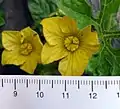 Watermelon flowers
Watermelon flowers Watermelon leaf
Watermelon leaf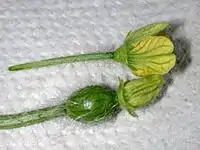 Flower stems of male and female watermelon blossoms, showing ovary on the female
Flower stems of male and female watermelon blossoms, showing ovary on the female Watermelon plant close-up
Watermelon plant close-up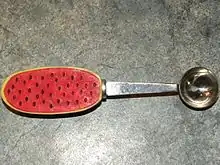
 Watermelon with yellow flesh
Watermelon with yellow flesh 'Moon and stars' watermelon cultivar
'Moon and stars' watermelon cultivar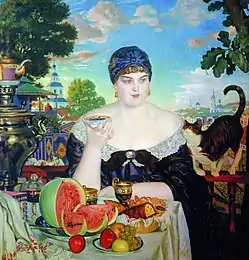 Watermelon and other fruit in Boris Kustodiev's Merchant's Wife
Watermelon and other fruit in Boris Kustodiev's Merchant's Wife Watermelon for sale
Watermelon for sale Watermelon out for sale in Maa Kochilei Market, Rasulgarh, Odisha, India
Watermelon out for sale in Maa Kochilei Market, Rasulgarh, Odisha, India Watermelon grown in Buryatia, Siberia
Watermelon grown in Buryatia, Siberia Watermelon rind curry
Watermelon rind curry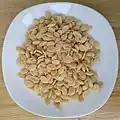 Roasted and salted watermelon seeds
Roasted and salted watermelon seeds Watermelon seed under a microscope
Watermelon seed under a microscope
See also
References
- "The Plant List: A Working List of All Plant Species". Retrieved 16 April 2014.
- Wasylikowa, Krystyna; van der Veen, Marijke (2004). "An archaeobotanical contribution to the history of watermelon, Citrullus lanatus (Thunb.) Matsum. & Nakai (syn. C. vulgaris Schrad.)". Vegetation History and Archaeobotany. 13 (4): 213–217. doi:10.1007/s00334-004-0039-6. ISSN 0939-6314. JSTOR 23419585. S2CID 129058509. Retrieved 14 December 2020.
- "Citrullus lanatus (Thunb.) Matsum. & Nakai". South Africa National Biodiversity Institute. Retrieved 17 October 2013.
- "A Systematic Treatment of Fruit Types". Worldbotanical.com. Retrieved 7 October 2014.
- Maynard, David; Maynard, Donald N. (2012). "6: Cucumbers, melons and watermelons". In Kiple, Kenneth F.; Ornelas, Kriemhild Coneè (eds.). The Cambridge World History of Food, Part 2. Medical History. 46. Cambridge University Press. pp. 267–270. doi:10.1017/CHOL9780521402156. ISBN 978-0-521-40215-6. PMC 1044500. PMID 16562324.
- "Citrullus lanatus (Thunb.) Matsum. & Nakai". South Africa National Biodiversity Institute. Retrieved 4 October 2014.
- Parsons, William Thomas; Cuthbertson, Eric George (2001). Noxious Weeds of Australia (2nd ed.). Collingwood, Victoria: CSIRO Publishing. pp. 407–408. ISBN 978-0643065147. Retrieved 17 April 2014.
- Bailey LH. 1930. Three discussions in Cucurbitaceae. Gentes Herbarum 2: 175–186.
- Chomicki, G.; S. S. Renner (2014). "Watermelon origin solved with molecular phylogenetics including Linnaean material: Another example of museomics". New Phytologist. 205 (2): 526–32. doi:10.1111/nph.13163. PMID 25358433.
- Renner, S. S.; G. Chomicki & W. Greuter (2014). "Proposal to conserve the name Momordica lanata (Citrullus lanatus) (watermelon, Cucurbitaceae), with a conserved type, against Citrullus battich". Taxon. 63 (4): 941–942. doi:10.12705/634.29. S2CID 86896357.
- "Citrullus vulgaris Schrad.", The International Plant Names Index, retrieved 26 September 2019
- Renner, S. S., A. Sousa, and G. Chomicki. 2017. Chromosome numbers, Sudanese wild forms, and classification of the watermelon genus Citrullus, with 50 names allocated to seven biological species. Taxon 66(6): 1393-1405.
- "Momordica lanata Thunb". Australian Plant Name Index (APNI), IBIS database. Centre for Plant Biodiversity Research, Australian Government, Canberra. Retrieved 17 October 2013.
- "Citrullus lanatus (Thunb.) Matsum. & Nakai". Australian Plant Name Index (APNI), IBIS database. Centre for Plant Biodiversity Research, Australian Government, Canberra. Retrieved 17 October 2013.
- Guillaume Chomicki; Susanne S. Renner (31 October 2014). "Watermelon origin solved with molecular phylogenetics including Linnaean material: another example of museomics". New Phytologist. Wiley-Blackwell. 205 (2): 526–532. doi:10.1111/nph.13163. PMID 25358433.

- Strauss, Mark (21 August 2015). "The 5,000-Year Secret History of the Watermelon". National Geographic News. Archived from the original on 16 October 2020. Retrieved 15 October 2020.
- Zohary, Daniel and Hopf, Maria (2000) Domestication of Plants in the Old World, third edition, Oxford University Press, p. 193, ISBN 0-19-850357-1.
- Amar, Zohar (5 December 2016). Arabian Drugs in Medieval Mediterranean Medicine. Edinburgh University Press. ISBN 9781474413183. Retrieved 26 August 2019.
- Black, William R. "How Watermelons Became a Racist Trope". The Atlantic. The Atlantic Monthly Group. Retrieved 8 March 2020.
- Greenlee, Cynthia (29 August 2019). "On eating watermelon in front of white people: "I'm not as free as I thought"". Vox. Retrieved 29 August 2019.
- "Production of Seedless Watermelons". US Department of Agriculture. 15 June 1971. Retrieved 31 May 2017.
- Naeve, Linda (December 2015). "Watermelon". agmrc.org. Agricultural Marketing Resource Center. Retrieved 31 May 2017.
- Brickell, Christopher (ed) (1992). The Royal Horticultural Society Encyclopedia of Gardening (Print). London: Dorling Kindersley. p. 333. ISBN 978-0-86318-979-1.CS1 maint: extra text: authors list (link)
- "Watermelon Variety Descriptions". Washington State University. Retrieved 2 October 2014.
- Johnson, Gordon C.; Ernest, Emmalea Garver (September 2011). Conditions Influencing Hollow Heart Disorder In Triploid Watermelon. ASHS Annual Conference.CS1 maint: date and year (link)
- Thomas, Adam (18 June 2015). "Saving watermelons". University of Delaware. Retrieved 26 June 2020.
- "Square fruit stuns Japanese shoppers". BBC News. 15 June 2001.
- "Square watermelons Japan. English version". YouTube. 6 November 2013. Retrieved 3 August 2014.
- Porcher, Michel H. "Multilingual Multiscript Plant Name Database". Sorting Citrullus names. Retrieved 17 October 2013.
- "Citrullus lanatus (watermelon)". Royal Botanic Gardens (Kew). Retrieved 17 October 2013.
- "Vegetable Research & Extension Center – Icebox Watermelons". Retrieved 2 August 2008.
- "Heaviest watermelon". Guinness World Records. Retrieved 2 July 2015.
- "Watermelon growing contest". Georgia 4H. The University of Georgia College of Agricultural and Environmental Sciences. 2005. Retrieved 5 October 2014.
- "Golden Midget Watermelon". Archived from the original on 11 October 2007. Retrieved 5 October 2014.
- "Orangeglo Watermelon". Archived from the original on 27 September 2007. Retrieved 23 April 2007.
- "Moon and Stars Watermelon Heirloom". rareseeds.com. Archived from the original on 17 December 2007. Retrieved 15 July 2008.
- Evans, Lynette (15 July 2005). "Moon & Stars watermelon (Citrullus lanatus) — Seed-spittin' melons makin' a comeback". The San Francisco Chronicle. Archived from the original on 13 October 2007. Retrieved 6 July 2007.
- "Moon and Stars Watermelon". Archived from the original on 2 June 2007. Retrieved 23 April 2007.
- "Watermelon, Cream Saskatchewan". seedsavers.org. Archived from the original on 21 February 2009.
- "Melitopolski Watermelon". Archived from the original on 27 September 2007. Retrieved 23 April 2007.
- Hosaka, Tomoko A. (6 June 2008). "Black Japanese watermelon sold at record price". The Associated Pres. Archived from the original on 9 June 2008. Retrieved 10 June 2008.
- Todd C. Wehner (2008). "12. Watermelon". In Jaime Prohens and Fernando Nuez (ed.). Handbook of plant breeding. Volume 1, Vegetables. I, Asteraceae, Brassicaceae, Chenopodicaceae, and Cucurbitaceae. Handbook of Plant Breeding. 1. Springer. pp. 381–418. doi:10.1007/978-0-387-30443-4_12. ISBN 978-0-387-72291-7.
- "Watermelon developer dies at 101". Post and Courier, 16 July 2007
- "Florida produces more watermelon than any other state". 16 July 2019.
- "Good reasons for icebox melons". The Free Library. Sunset. 1 May 1985. Retrieved 4 October 2014.
- "Watermelon production in 2017, Crops/Regions/World list/Production Quantity (pick lists)". UN Food and Agriculture Organization, Corporate Statistical Database (FAOSTAT). 2018. Retrieved 25 August 2019.
- "Watermelon". g Marketing Resource Center, US Department of Agriculture, Iowa State University. 2017. Retrieved 9 May 2017.
- "Top 10 ways to enjoy watermelon". Produce for Better Health Foundation, Centers for Disease Control, US National Institutes of Health. 2017. Retrieved 9 May 2017.
- Ogodo, A. C.; Ugbogu, O. C.; Ugbogu, A. E.; Ezeonu, C. S. (2015). "Production of mixed fruit (pawpaw, banana and watermelon) wine using Saccharomyces cerevisiae isolated from palm wine". SpringerPlus. 4: 683. doi:10.1186/s40064-015-1475-8. PMC 4639538. PMID 26576326.
- Shiu-ying Hu (2005). Food Plants of China. Chinese University Press. p. 125. ISBN 978-962-996-229-6.
- The Asian Texans By Marilyn Dell Brady, Texas A&M University Press
- Bryant Terry (2009). Vegan Soul Kitchen: Fresh, Healthy, and Creative African-American Cuisine. Da Capo Press. p. 46. ISBN 978-0-7867-4503-6.
- "Oklahoma Declares Watermelon Its State Vegetable". CBS4denver. 18 April 2007. Archived from the original on 2 March 2008. Retrieved 3 October 2009.
- "Watermelon, raw". Nutritional data. Self. Retrieved 5 October 2014.
- Perkins-Veazie P, Collins JK, Davis AR, Roberts W (2006). "Carotenoid content of 50 watermelon cultivars". J Agric Food Chem. 54 (7): 2593–7. doi:10.1021/jf052066p. PMID 16569049.CS1 maint: uses authors parameter (link)
- Rimando AM, Perkins-Veazie PM (2005). "Determination of citrulline in watermelon rind". J Chromatogr A. 1078 (1–2): 196–200. doi:10.1016/j.chroma.2005.05.009. PMID 16007998.CS1 maint: uses authors parameter (link)
- The Associated Press (3 July 2008). "CBC News – Health – Watermelon the real passion fruit?". CBC. Retrieved 3 August 2014.
External links
| Wikispecies has information related to Citrullus vulgaris. |
| Wikimedia Commons has media related to Citrullus lanatus. |
- Watermelon.org from the US National Watermelon Promotion Board
